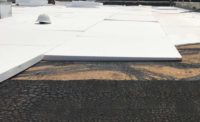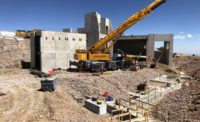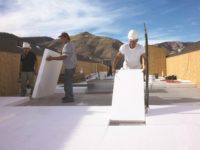You likely would not be surprised to hear that Facebook this year installed a 9-acre garden roof on its new office building. But, more than just another perk for Bay Area tech hipsters like in-office nap pods and on-site dry cleaning, so-called green or vegetated roofs have been around for decades and are growing in popularity. In fact, the U.S. General Services Administration (GSA) maintains more than 2 million square-feet of green roofs, with their oldest one—on the Robert F. Kennedy Department of Justice building in Washington, D.C.—dating to 1935.
North of the border, Toronto was the first North American city to require vegetated roofs for new developments, having passed its Green Roof Bylaw in 2009.
Green roofs range from ones with simple ground cover plants up to full-fledged park spaces with shrubs and trees. Two things most of them have in common is the need to reduce structural loads and keep water out of the building.
Benefits of Green Roofs
Building owners are increasingly interested in green roofs because of myriad benefits they offer. The GSA notes that “green roofs can help mitigate the problems that cities create by bringing the natural cooling, water treatment and air filtration properties that vegetated landscapes provide to the urban environment.” In short, green roofs help slow down urban run-off and filter-out rain-born and air pollutants. Additionally, green roofs provide better aesthetics and new amenity spaces for people and wildlife, according to the Green Roofs for Healthy Cities (GRHC) non-profit association.
Two Challenges of Green Roofs
A key challenge with designing and building a green roof is accounting for the increased dead loads (weight) imposed by the soil (or other growing medium), plants and other landscape finishes like planters, edgers, pathway materials, etc. With their numerous layers, the complex roofing assemblies required for green roofs also impose greater weight on the roof structure than do conventional assemblies. Such layers above the roof deck typically include the following, as summarized by Green Roofs for Healthy Cities:
- Vapor control
- Thermal insulation
- Support panel
- Waterproofing/root repellant layer
- Drainage layer
- Filter membrane
- Growing medium
- Vegetation
A second key challenge with implementing green roofs is ensuring a water-tight assembly, especially as the growing medium will retain moisture longer than a standard roof does.
Addressing the Challenges of Weight and Water
To address the challenges of weight and moisture retention, as well as to provide thermal insulation, more roofing professionals are incorporating expanded polystyrene (EPS) geofoam in their green roofs. The material’s physical properties are outlined below.
Weight
For green roofs with park-like landscaping, soil is prohibitively heavy for creating berms and rises. Instead, EPS geofoam provides an ultralight fill alternative. The weight of EPS geofoam ranges from 0.7 to 2.85 pounds-per-cubic-feet depending on the density specified, compared to 110 to 120 pounds-per-cubic-feet for soil, which varies based on its composition and moisture content. As such, geofoam weighs about 100 times less than soil, which allows it to be used for sculpting interesting landscape features on green roofs.
Compressive strength
Although it is very low weight, EPS geofoam is engineered for high strength, with compressive resistance values of about 317 to 2,678 pounds-per-square-foot at a 1 percent deformation. In fact, geofoam has better bearing capacity than most foundation soils. The material is often used in civil engineering projects such as embankment fill under highways and runways, so is strong enough to support the loads of green roofs.
Moisture absorption
EPS geofoam absorbs only from 2-4 percent moisture by volume, depending on the type specified, and it dries quickly. This is a crucial performance factor in green roofs because retained water adds weight to the roof assembly, and excess moisture can lead to water infiltration into the building.
Thermal performance
As EPS is one of the most commonly used rigid foam insulations in roof assemblies, it has a long history of helping create well-insulated roofs. The material provides the highest R-value per dollar, a trait it maintains when used as geofoam. Additionally, because EPS is made with blowing agents that do not diffuse over time, it has stable long-term R-values.
Project Examples
Building professionals have used EPS geofoam to create durable green roofs in many projects throughout North America. Following are two prominent examples.
Facebook Office Building
In 2015, Facebook opened a new 430,000-square-foot office building called MPK 20 on its headquarters campus in Menlo Park, Calif. Designed by renowned architect Frank Gehry, the building includes a 9-acre green roof with more than 400 trees and a half-mile walking trail. To help create the sculpted park-like space for the company’s employees, the project team used EPS geofoam manufactured by Insulfoam.
Maggie Daley Park
While many people would not recognize it as a green roof, Chicago’s Maggie Daley Park on Lake Michigan relies on EPS geofoam for its light weight. Opened in 2015, the 28-acre park lies on top of the 3,700-car East Monroe Street Parking Garage. The park’s landscape architects, Michael Van Valkenburgh Associates (Brooklyn, N.Y.), envisioned extensive earthworks, which they described as “curvilinear, topographically dramatic and relentlessly heterogeneous.” Because the park’s hills and valleys would have required expensive structural enhancements to the garage if those features were built-up using soil, the design team used geofoam as a lightweight fill alternative.
Conclusion
While a well-designed green roof looks no different than an earthbound landscaped space, the assemblies require careful attention to details, including weight and water management. Given its ultra-low weight and minimal long-term moisture retention, EPS geofoam can help create a durable and economical green roof.






